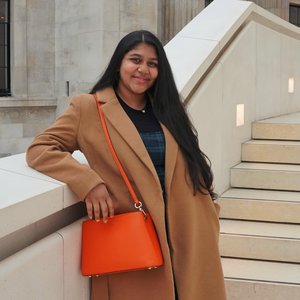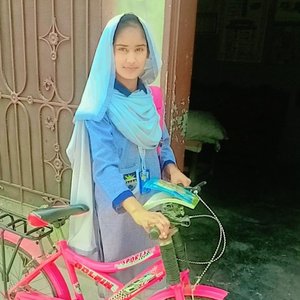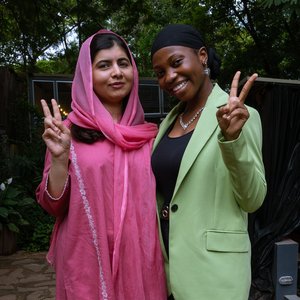South Asians on the big screen
21-year-old student and radio host Nila Varman in the U.K. writes about the misrepresentation of South Asians in the media. (Couresty of Nila Varman)
21-year-old student and radio host Nila Varman in the U.K. writes about the misrepresentation of South Asians in the media.
Born and brought up in the U.K. as a young, Brown, Tamil girl, I quickly noticed that there was never anyone on TV, in movies or even in books and magazines who looked like me. Whenever a film or an episode on TV came out with a South Asian character in it, my initial excitement would be drowned by waves of disappointment when I realised that this character — who I wanted to relate to — would not be the main focus of the show. They were sadly just a side character with stereotypical characteristics like a fake or overexaggerated accent, purposefully long and complicated names and highly conservative, nerdy, naive, “exotic” and “mystical” personas who were either the supporting characters or the root of an ongoing joke. Sometimes, they weren’t even played by a South Asian actor — like when Max Minghella played Divya Narendra, an Indian American character (and real-life person!) in “The Social Network” or when Ashton Kutcher wore Brownface to play a Bollywood reporter in an advertisement for Popchips.
My whole life, society has expected me to relate to stereotypically represented characters like Apu from the Simpsons, who was voiced by a Caucasian man with the most exaggerated Indian accent and an inauthentic surname that even Indian people struggle to pronounce. But I didn’t realise just how bad the representation of Brown people was until I learned the truth about the movie “Short Circuit 2.” When I was younger, we had an old cassette of this movie which tells the story of an Indian scientist and his robot. I thought that movie was incredible because the main character was a scientist and he was inventing new things. Little did I know that the Indian scientist was played by Fisher Stevens, a White actor in Brownface. As Aziz Ansari says in his show “Master of None”: “They managed to get a fake Indian, but a real robot.”
As a girl of colour, I struggled to resonate with the lack of representation I’d see on the big screen. I’d received the standard talks growing up: what to do if someone treated me differently because of my brown skin, how to love the brownness of my skin, how to be proud of where I come from, how I might need to stand my ground in the future. But the lack of real representation of South Asians on TV for my age-group audience made me feel a deep sense of shame about my skin. I was constantly yearning for someone to share my perspectives, a character I saw myself in and to whom I could relate.
“The lack of real representation of South Asians on TV for my age-group audience made me feel a deep sense of shame about my skin. I was constantly yearning for someone to share my perspectives, a character I saw myself in and to whom I could relate.”
As I got a little older, Ravi Ross arrived on the Disney Channel show “Jessie” and, for the first time, I saw a South Asian actor play a main character on a major TV show. I had wished for so long to see someone of a similar age to me, who looked like me, go through everyday life on TV, and so I was over the moon when I first saw the promos. Little did I know that Ravi would turn out to be a mix of watered-down racism and Disney-friendly distortions of South Asian culture. On “Jessie,” Ravi displayed every possible stereotype of an Indian person — his entire character arc was based on having the best grades and a non-existent social life, an exaggerated accent and never being good enough for girls or love. “Jessie” reduced him to just his ethnicity; Ravi only wore traditional Indian clothes on the show and played the sitar, a traditional Indian instrument. This portrayal made me feel embarrassed, as if that was all I could ever be in life. Sadly, just as I feared, the stereotypes portrayed on the show became the stereotypes my peers would come to associate me with. That — and the characters from Indiana Jones and the Temple of Doom.
This is the danger of failures of representation; for some people, seeing these characters in TV shows, movies and books may be their first ever encounter with certain cultures and communities. Characters like Raj Koothrappali in the “Big Bang Theory,” Baljeet in “Phineas and Ferb” and Dopinder in “Deadpool” — which portray South Asians as weak and nerdy — influence the way audience members treat and perceive South Asian people off screen.
“The lack of real representation of South Asians on TV for my age-group audience made me feel a deep sense of shame about my skin. I was constantly yearning for someone to share my perspectives, a character I saw myself in and to whom I could relate,” writes Nila. (Courtesy of Nila Varman)
These problematic portrayals have gone unquestioned and disregarded for years. But thankfully, we are beginning to see a shift in representation. Slowly but surely, people like Mindy Kaling and Aziz Ansari are changing the narrative of how South Asians are represented on the big screen. With popular TV shows like “The Mindy Project,” “Never Have I Ever,” “Patriot Act with Hasan Minhaj,” “Master of None,” “Midnight Mass” and movies like “The Big Sick” and “Sound of Metal,” for the first time in a long time we are seeing South Asians as narrators of their own stories, mental health struggles and everyday dilemmas.
These characters are just ordinary people. Finally, the entertainment industry is getting the message that the only Brown character in a show or movie doesn’t need to perform a song or have a stereotypical Mridangam track accompanying their every word to prove that they are South Asian. They are just characters in a TV show — and they happen to be Brown. As a young South Asian woman with Tamil heritage and a British upbringing, movies and shows that portray South Asians as everyday people make me feel seen as an individual still finding her way in society. These movies make me feel empowered. They make me feel “normal.” These characters could be me, or my brother or my friend. I’ve realised that I am not alone in my struggles with becoming comfortable with the colour of my skin, and as a result I’ve become prouder of South Indian food, music and traditions, and of the contributions of Tamil people.
It is time to challenge the stereotypical representations we have been confined to for decades. Whether we do it by learning and unlearning ideas and biases, amplifying the voices of South Asian communities all over the world, calling out problematic portrayals, being an ally or creating a safe and inclusive space for those sharing their lived experience, it is time to honour the rich culture, history and stories of South Asian people — both on screen and off.
 Read more
Read more













